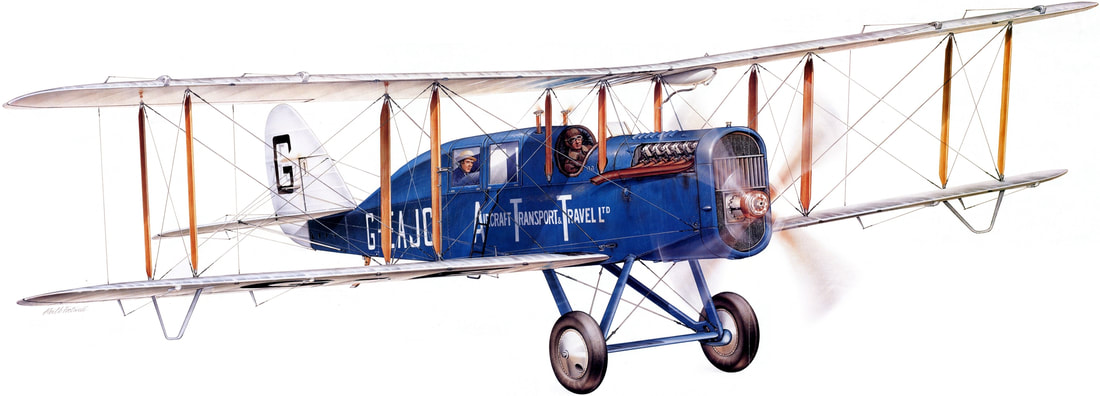 Airco DH4a K5764
Airco DH4a K5764
The DH4a Passenger Conversion
In March 1919, No. 2 (Communication) Squadron RAF was established in response to the growing need for ministerial transport across the English Channel, following the Armistice in November 1918. The squadron operated numerous unarmed DH4 aircraft between RAF Kenley and Paris. During the Peace Conference, a daily courier and mail service was provided in both directions, and numerous Cabinet Ministers and VIPs took advantage of this new and expedient mode of transport.
Upon request, several DH4 aircraft were modified to include a glazed cabin that could accommodate two delegates, allowing them to converse in comfort during the flight. This cabin, made of wood and covered in stretched Irish Linen, featured sliding windows, and was seamlessly blended into the tail unit.
The starboard side and roof of the cabin were hinged to fold upwards for easy entry and exit. While the regular DH4 retained its fuel tanks behind the pilot, with the two familiar wind-driven fuel pumps mounted above them, the cabin model had to be reconfigured due to the added weight of the extra passenger positioned further back. Consequently, the upper mainplane was moved 12 inches aft from its usual position, resulting in an unstaggered configuration. This modification distinguished the cabin model as a significant new variant, designated as the DH4a.
The DH4a was eventually used by several airlines in the immediate post-war period, including Transport and Aircraft Transport and Travel.
In March 1919, No. 2 (Communication) Squadron RAF was established in response to the growing need for ministerial transport across the English Channel, following the Armistice in November 1918. The squadron operated numerous unarmed DH4 aircraft between RAF Kenley and Paris. During the Peace Conference, a daily courier and mail service was provided in both directions, and numerous Cabinet Ministers and VIPs took advantage of this new and expedient mode of transport.
Upon request, several DH4 aircraft were modified to include a glazed cabin that could accommodate two delegates, allowing them to converse in comfort during the flight. This cabin, made of wood and covered in stretched Irish Linen, featured sliding windows, and was seamlessly blended into the tail unit.
The starboard side and roof of the cabin were hinged to fold upwards for easy entry and exit. While the regular DH4 retained its fuel tanks behind the pilot, with the two familiar wind-driven fuel pumps mounted above them, the cabin model had to be reconfigured due to the added weight of the extra passenger positioned further back. Consequently, the upper mainplane was moved 12 inches aft from its usual position, resulting in an unstaggered configuration. This modification distinguished the cabin model as a significant new variant, designated as the DH4a.
The DH4a was eventually used by several airlines in the immediate post-war period, including Transport and Aircraft Transport and Travel.
 Airco DH4a G-EAJC flew the
first British commercial passenger
Airco DH4a G-EAJC flew the
first British commercial passenger service from Hounslow Heath Aerodrome to Paris Le Bourget
on 25 August 1919.
Aircraft Transport and Travel (AT&T) was a British airline that operated during the early 20th century. Founded in 1916, it was one of the first airlines to offer scheduled passenger service, and played an important role in the development of commercial aviation. AT&T was founded by George Holt Thomas, a British businessman who had previously been involved in the automobile industry. Thomas saw the potential for air travel and began investing in aircraft, eventually founding AT&T as a subsidiary of his Automobiles and General Transport Company.
Initially, AT&T focused on providing air taxi services for wealthy individuals, but in 1919 it began offering scheduled passenger service between Hounslow Heath Aerodrome to Paris Le Bourget. This London-Paris service was a success, and in 1920 AT&T expanded to offer service to other European cities, including Amsterdam and Brussels. By 1922, the airline was carrying over 10,000 passengers per year.
In addition to passenger service, AT&T also operated a mail service between London and Paris, and was the first airline to carry mail on a regular basis. Despite its early success, AT&T faced financial difficulties in the mid-1920s, due in part to increased competition from other airlines. In 1927, the airline was acquired by British Marine Air Navigation Company (BMAN), which later became part of Imperial Airways.
Initially, AT&T focused on providing air taxi services for wealthy individuals, but in 1919 it began offering scheduled passenger service between Hounslow Heath Aerodrome to Paris Le Bourget. This London-Paris service was a success, and in 1920 AT&T expanded to offer service to other European cities, including Amsterdam and Brussels. By 1922, the airline was carrying over 10,000 passengers per year.
In addition to passenger service, AT&T also operated a mail service between London and Paris, and was the first airline to carry mail on a regular basis. Despite its early success, AT&T faced financial difficulties in the mid-1920s, due in part to increased competition from other airlines. In 1927, the airline was acquired by British Marine Air Navigation Company (BMAN), which later became part of Imperial Airways.

